Dust baths for chickens and what to fill them with

If you’ve never seen a chicken dust bathing, the sight can give you quite a shock. Chickens lying around in the dirt while vigorously twitching its feet and flopping its wings and rolling their heads, the chicken first looks like it’s having an uncontrollable fit.
Then it lies perfectly still in the hole it just dug, looking like death itself. Go over to check on the bird and it will jump up and shake itself off, filling the surrounding air with fine dust.
Table of Contents
- Why do chickens dust bathe?
- Do chickens like to dust bathe?
- Do chickens need a dust bath?
- What do you put in the dust bath for chickens?
- Can I use play sand for chicken dust bath?
- Do chickens need a dust bath in winter?
- Where should you put a dust bath?
- Do baby chickens need dust baths?
- At what age do chickens start dust bathing?
- How big should a chicken dust bath be?
- How deep should a chicken dust bath be?
- Can chickens dust bathe in fire ash?
- What breeds of poultry use a dust bath?
- What can you use for a dust bath for chickens?
- Things you shouldn't add to the dust bath:
Below: A chicken enjoying a dust bath in the sand.
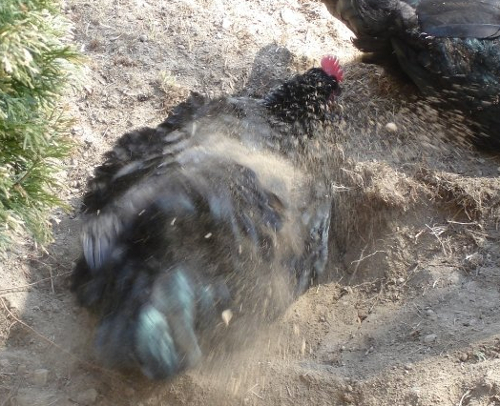
Dust bathing is the chickens way of keeping themselves clean, like we would bathe a dog, or shower ourselves. It just happens to be a distinct, and quite frankly, odd way of taking a bath.
It also acts as a natural insecticide and helps to keep parasites and other nasty creepy crawlies at bay, so it is important for their health! Dust bathing is also a relaxing and even social pastime for chickens. So don't forget to give your chickens a dust bath provisions.
One easy way to help your chickens beat mites, lice and parasites is with a dust bath. Additions like fine sand, DE, wood ash and aromatic herbs can help deter insect pests.
Why do chickens dust bathe?
Chickens and other poultry dust bath for four reasons:
- It helps deal with parasites like mites and lice.
- It keep their feathers and skin in good condition.
- It helps keep them cool in hot weather.
- It is a social activity that seems to promote well being.
Also at moulting time it will help loosen the old feathers and assist with the emerging feathers.
Below: Here is one of my Leghorn hens having a dust bath.
Do chickens like to dust bathe?
Chickens like dust baths as it naturally keeps their feathers clean and healthy and parasite free. It is also an instinctive behaviour that seems to help keep the birds happy, much like scratching is good for their mental health.
Dust bathing is a natural behaviour in chickens and in the UK and EU must be provided by law.
Below: Shaking out the feathers after a dust bath.
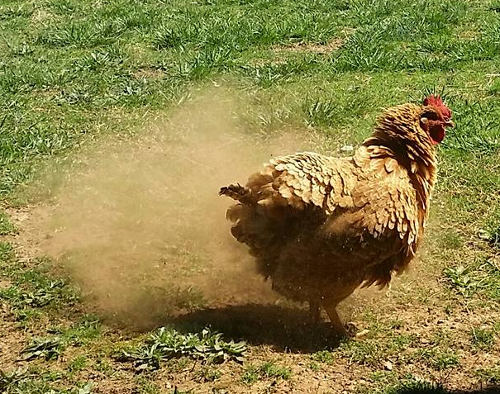
Do chickens need a dust bath?
Yes, all chickens need a dust bath. They dust bathe because they want to remove parasites from their feathers and excess oil from their skin. Dust bathing is an instinctive behaviour for several types of poultry, not just chickens.
They will pick the finest, most irritating dust they can find, because it also irritates the parasites. Fine silty sand, wood ashes, plaster dust, whatever they can find. Wood stove ashes, silica sand are all appropriate materials to put out for your birds.
Below: Dust baths are a social activity for flocks of chickens.
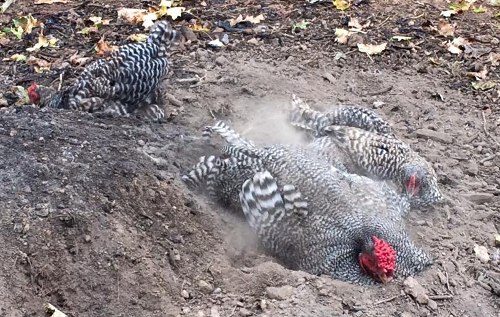
Some charred wood is also nice as they will eat the charcoal to absorb toxins in their gut. I have often seen chickens picking charcoal out from the ash.
What do you put in the dust bath for chickens?
The bulk of the contents of the dust bath should be clean dry sharp sand. You can use plain earth from your garden but the dryer and dustier it is the better. Fine Sand and Dry Dirt is the key to a good duct bath for your flock. Fine sand mixed with some dry dirt makes a great base on which to build your chicken runs dust bath.
There are two things you should always add:
- DE or diatomaceous earth. Super Fine Grade Diatomaceous Earth is excellent at killing lice, mites and other parasites by contact over a long period of time.
- Fire ash from a wood fire. You should never use ash from treated wood or coal or if you have burned plastics or waste in the fire.
There are a few other things that can be nice for both you and your flock. Try adding dried herbs like Rosemary, Sage, Lavender, Mint or Lemon Balm. You can grow your own and dry them yourself or just add chopped fresh herb to the dust bath.
I’ve seen people like to debate most on whether or not DE (Diatomaceous earth) is something that should be used. Some swear by it and others won’t go near it. Best thing to do is to educate yourselves on all the risks and benefits and then make a judgement call that works best for you and your flock.
DE is a known respiratory irritant. It is most effective when and no where near as effective when wet. DE or diatomaceous earth is best used on a regular basis as a mild preventative against mites.
It will not take care of a heavy infestation once it happens. It’s use is controversial even in the vet world as well, some advise against its use saying it creates lasting issues in the lungs.
Personally, I have used it in the corners of my coop and nesting boxes and at the end of the roosts before I lay down bedding and I choose not to use it regularly. I have never had any issues but I wear a mask when using it. See preventing mites and lice with DE.
Can I use play sand for chicken dust bath?
Play sand is just fine for chickens or you can buy a few bags of building sand from your merchant, it is probably much cheaper than play sand.
Other things you can use are:
Sawdust. Not camphor or heavily fragrant woods though.
Topsoil from your garden.
Don't use kitty litter as it often contains fragrances and deodorisers and avoid commercially produced wood pellets and ash from processed logs and coal fires.
Do chickens need a dust bath in winter?
Chickens will use a dust bath in winter although they do not need it as much when it is cold as the lice and mites are less likely to be a problem.
I provide one all year round and you should as well. I use my greenhouse at the end of the growing season as it gets lovely and dry in there and the birds do all the cultivating of the soil for me.
Below: A winter dust bath in the greenhouse. Covered and nice and dry.

They help to clean up any bugs as well.
Where should you put a dust bath?
Dust baths for chickens should be sited in a dry, covered and easily accessible areas, otherwise they could be almost anywhere.
Chickens are pretty good at finding their own place for a dust bath. Let them guide you if you can not decide.
Below: This naughty girl has made use of a flower pot.
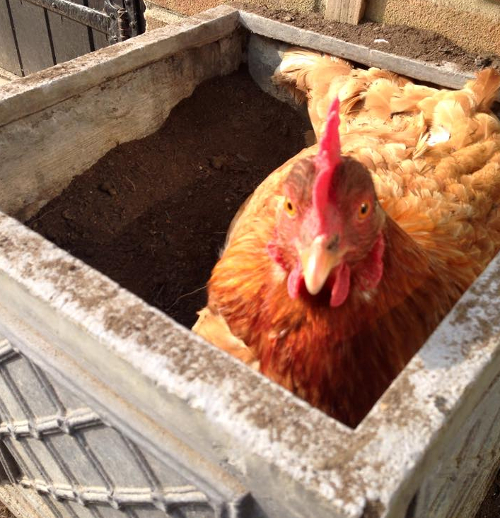
They constantly dig deep holes, about a foot, then plop down in it and dust bathe.
Below: They're so happy with that particular soil around the tree - they aren't interested in anything else I've offered. If it works, it works!
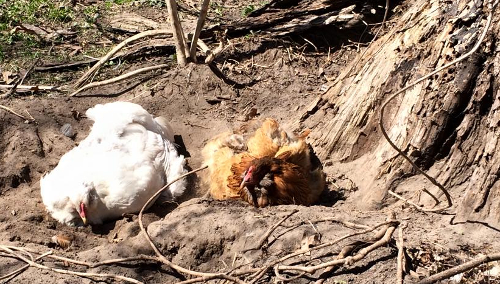
I have a friend who keep hens and hers seem to prefer the good old fashioned dirt under the porch.
Do baby chickens need dust baths?
Not as much when they are very young but they will benefit from having access to a dust from from as early as a week old. It seems to be a natural behaviour that chicks indulge in even if there is no mother hen to show they how to do it.
Below: Mum will teach them from a very young age.
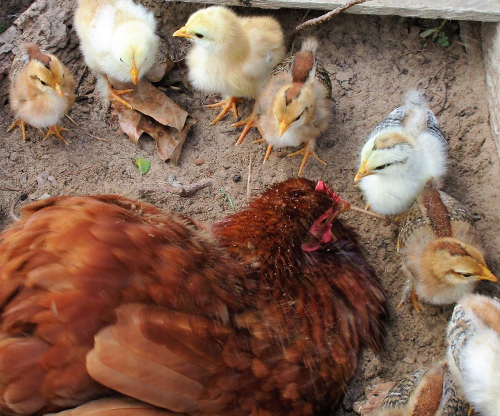
At what age do chickens start dust bathing?
Anyone who has ever raised chickens will know that they begin to use a dust bath as soon as they are able. This is from as little as a week old. If you use sand on your brooder floor then baby chicks will begin to use it from quite young.
Below: This young 5 week old Wyandotte chick has got the hang of it.
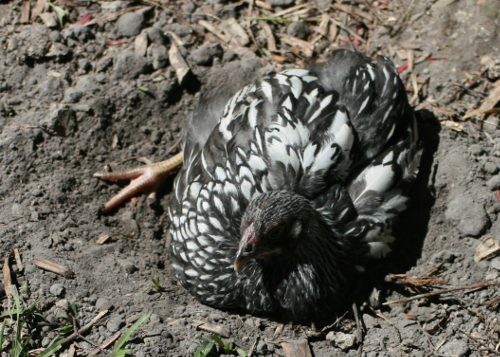
If you are a chicken it is never too early for a dust bath!
How big should a chicken dust bath be?
About 1 square foot per chicken. Chickens like a communal dust bath so the size of your dust bath depends on how many chickens you are keeping. It really needs to be a square foot per bird as there is often a lot of dusting and flapping when the birds are in the bath.
Below: Quite large is the answer. The bath needs to be big enough for a hen, or several hens, to lay out on their side.
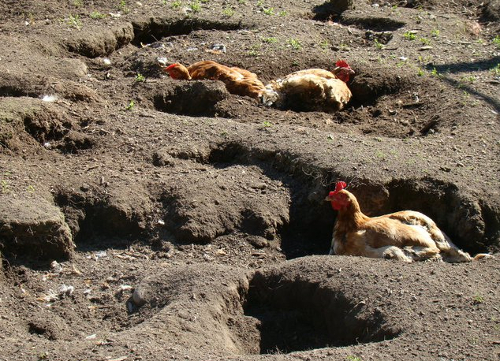
It's not uncommon for birds to cluster together in groups whilst they roll around in the dust so if you are making one then take the number of birds you have into consideration in the planning stages.
How deep should a chicken dust bath be?
A dust bath for chickens should be least 8 inches deep for full size chickens and 6 inches for bantams.
If left to dig their own holes for dust baths they can be quite deep. During the winter I let mine use the greenhouse and they can excavate holes around a foot deep.
Below: Deep enough to fit a chicken!
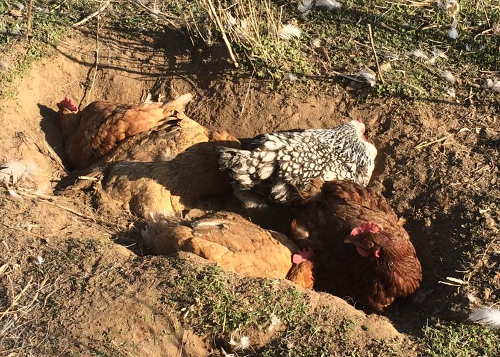
Chickens will however try to have a dust bath in as little as two inches of sand but they prefer a deeper one.
Can chickens dust bathe in fire ash?
Yes. I have often seen my chickens taking a dust bath in the ashes of a fire and as long as it is out and cold it is good for them.
It is one of my must add ingredients to my flocks bathing area, I just add a few handfuls into the hollows they have made and let them do the mixing themselves.
What breeds of poultry use a dust bath?
Turkeys, quail and Guinea fowl love to bathe in the dust so it isn't just chickens. It's a tried and true method of parasite prevention. Plus, they all seem just seem to enjoy it!
Below: A turkey making use of a dust bath.

Below: Here is Guinea fowl having a dust bath.
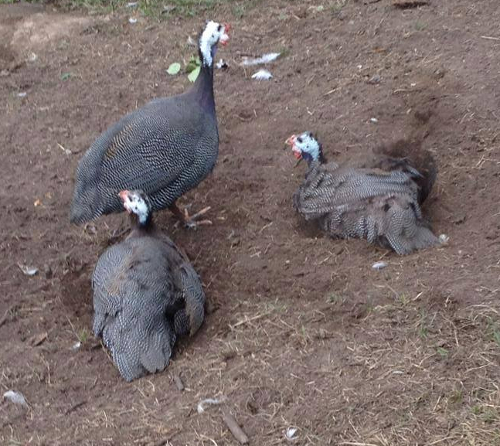
Most other birds and poultry with the exception of ducks and waterfowl will bath in dust.
What can you use for a dust bath for chickens?
Things you can use or re-purpose to make a dust bath for your flock include:
- Large plastic sandpits
- Kids paddling pools if they are sturdy enough.
- Large flat plastic totes
- Homemade wooden boxes.
- Half a barrel cut down it's length.
- A large flower pot.
Things you shouldn't add to the dust bath:
Straw has hollow straws which are notorious for housing lice, mites and mould.
Avoid cat litter for chicken dust bath as it contains additives and fragrances
I would not use coal ash, which will have mercury, sulphur and heavy metals and can be smelly.
I wouldn't trust fire log ash from commercially compressed logs or pellets. They ground up everything, wood, adhesives, varnish, stain, etc and added glue to make pellets. They also used old pallets with god knows what spilled on them, any trash wood. I wouldn’t use pellet ash for birds for that reason. Home pellets contain glues and accelerates and they may have a tiny amount of vegetable oil from the lubrication on the pellet machines.
I just mix dry top soil, sand, DE and wood ash from my wood stove. Wood ash as long as you aren't burning something with chemicals on it like lead paint or old asphalt shingles. Clean wood, burned hot, makes clean ashes.
